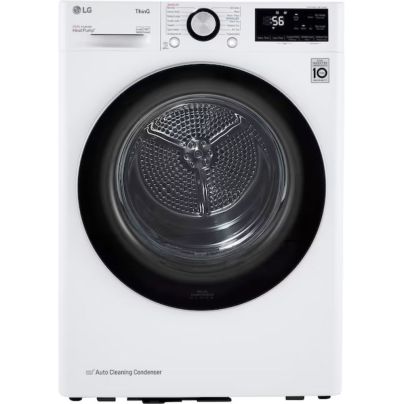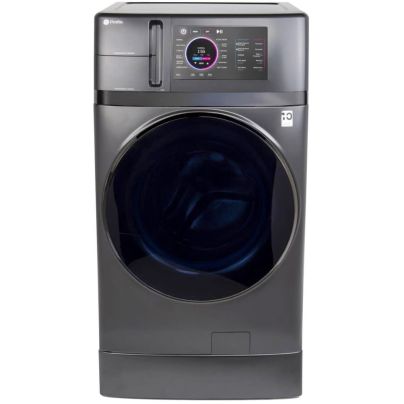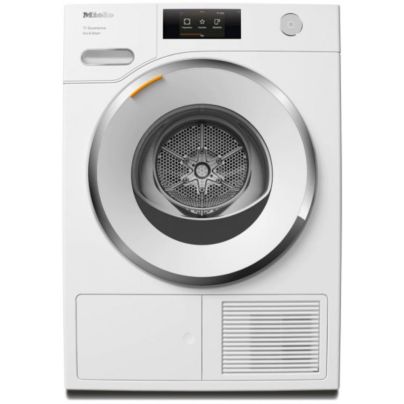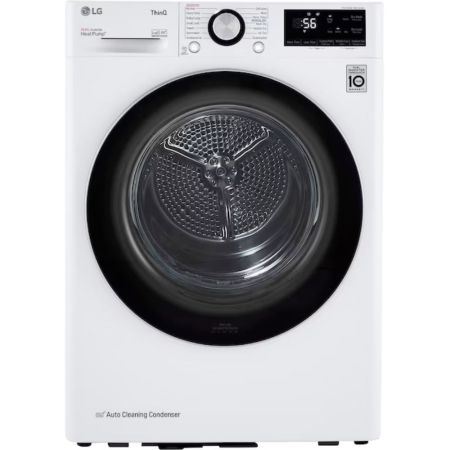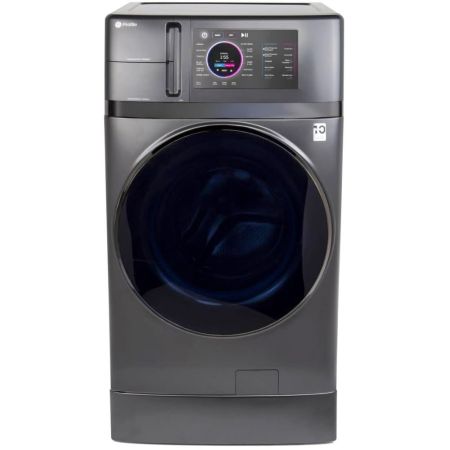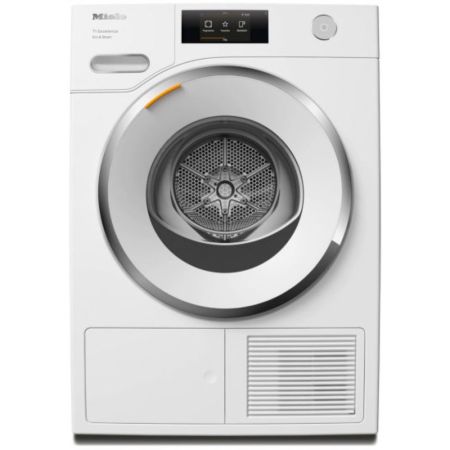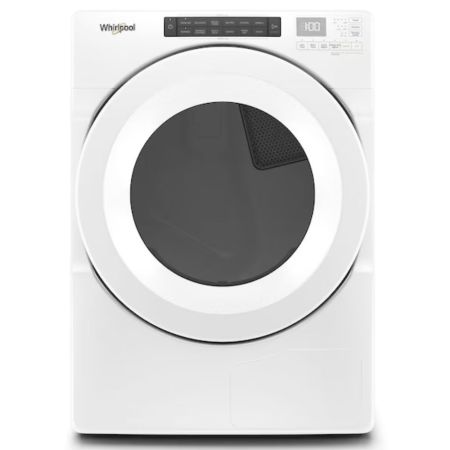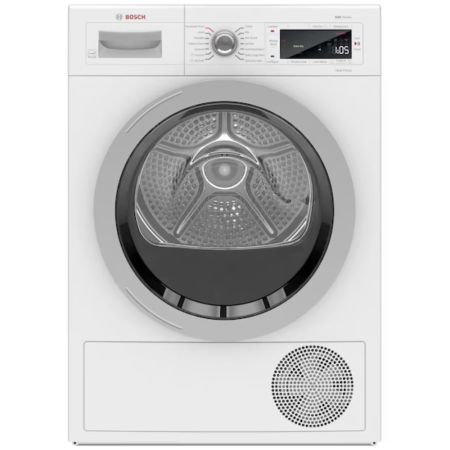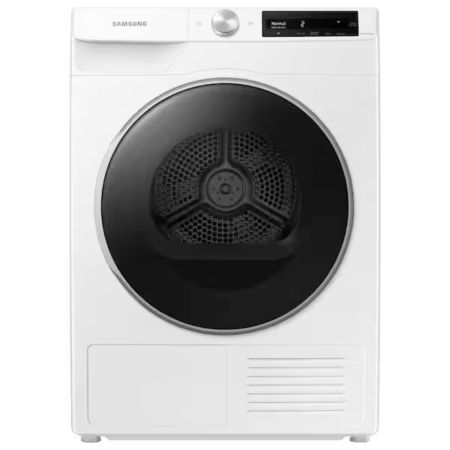We may earn revenue from the products available on this page and participate in affiliate programs. Learn More ›
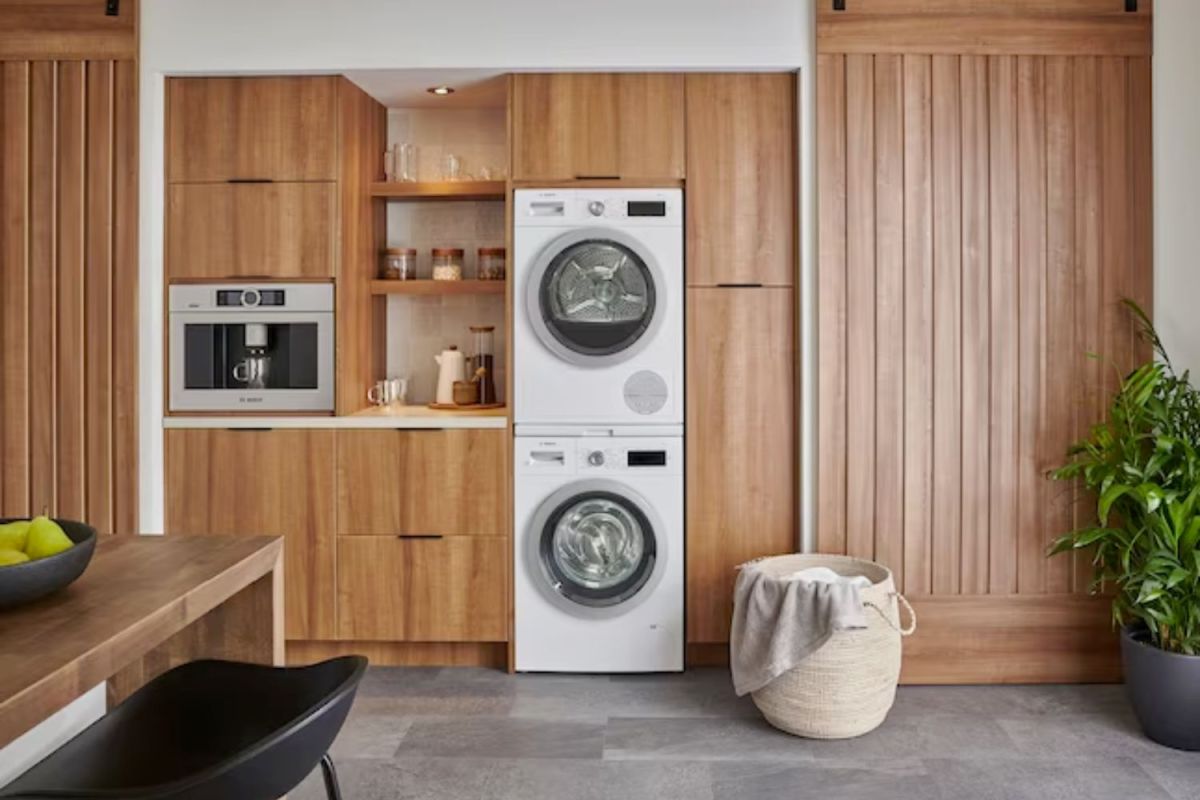
Heat pump dryers can reduce a high electricity bill, especially during winter months when it’s often not possible to dry laundry outdoors. They are also an excellent option for those who have little or no outdoor space because they don’t require a vent and can be installed almost anywhere.
However, finding the right model can be challenging. Many people don’t understand the technology and may be further confused by the inclusion of hybrid and ventless dryers. This guide will clarify what these different specifications mean while offering our picks for the best heat pump dryers currently available so potential buyers can make an informed decision.
- BEST OVERALL: LG 4.2 cu. ft. Smart Heat Pump Dryer
- BEST BANG FOR THE BUCK: GE Profile 4.8 cu. ft. Heat Pump Washer/Dryer
- UPGRADE PICK: Miele T1 Eco and Steam Heat Pump Dryer
- BEST HIGH-CAPACITY: Whirlpool 7.4 cu. ft. Heat Pump Dryer
- BEST DESIGN: Bosch 500 Series 4 cu. ft. Heat Pump Dryer
- ALSO CONSIDER: Samsung 4.0 cu. ft. Heat Pump Dryer With Wi-Fi
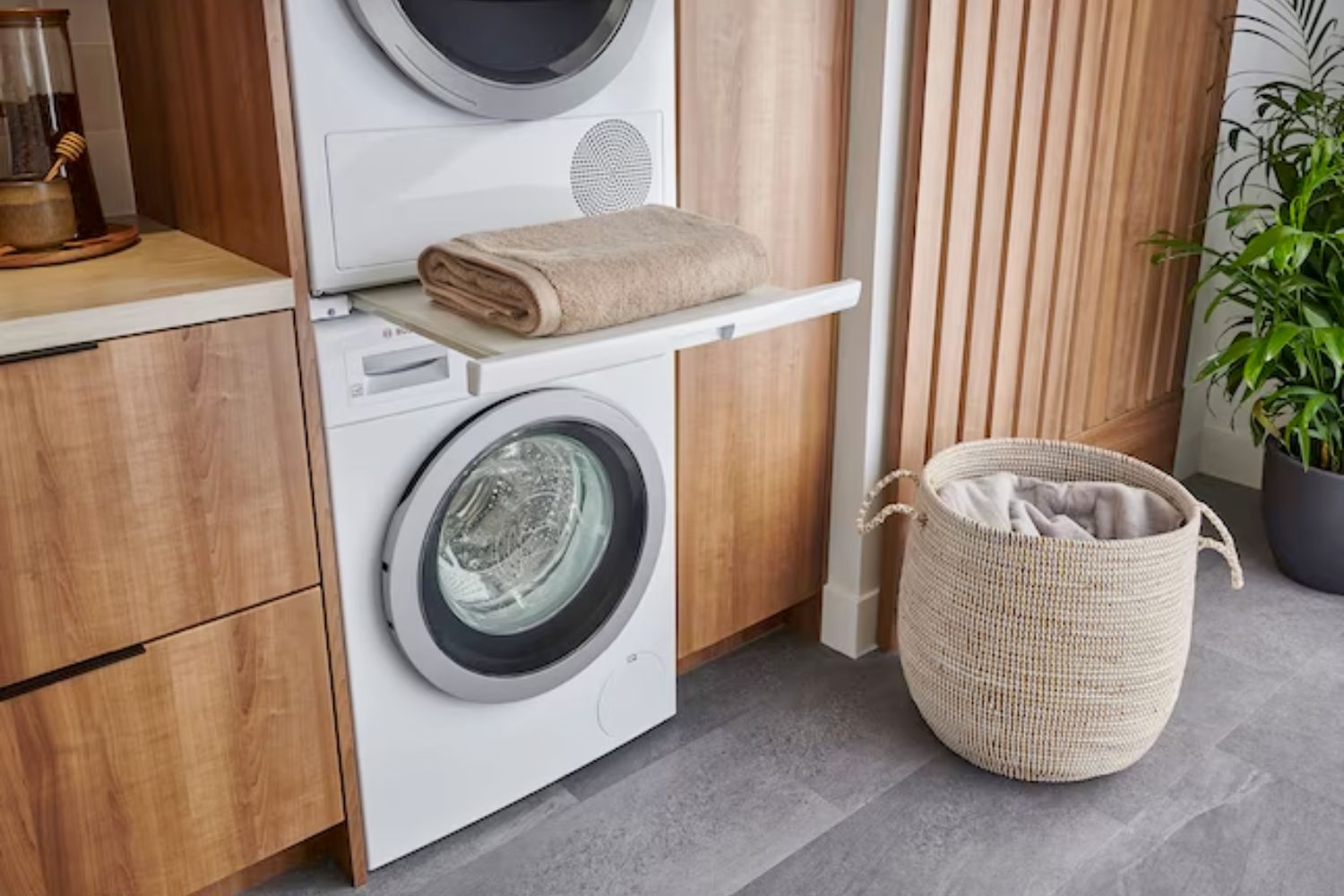
How We Chose the Best Heat Pump Dryers
The potential savings offered by a heat pump clothes dryer have made these machines increasingly popular, although there are currently not as many options to choose from as there are for traditional electric or gas dryers. This fact gave us an advantage: We were able to research almost every electric heat pump dryer on the market—two dozen models from all the leading manufacturers—to determine the best heat pump dryers available.
Performance is always a key factor, and we evaluated capacities and features. We considered the physical size of each dryer to reveal any major differences and reviewed owner feedback to expose any common faults or reliability issues. Finally, we tried to find heat pump dryers that would fit a variety of budgets.
Jimmy Hiller, founder and president of Hiller Plumbing, Heating, Cooling & Electrical, explains the advantages these appliances offer. “If energy savings and gentle fabric care are priorities, then a heat pump dryer could be a great fit.” He suggests that users consider the size and capacity of the dryer to ensure it meets the household’s needs and suggests that “to maximize your energy savings, look for models with a high energy rating when shopping.”
Our Top Picks
Our top picks include as much diversity as possible for sizes, features, and price points, thus providing choices for all potential buyers. Read on to learn about the six machines we believe represent the best heat pump dryers in their respective categories.
Best Overall
LG 4.2 cu. ft. Smart Heat Pump Dryer
See ItProduct Specs
- Capacity: 4.2 cubic feet
- Size: 33.5 inches high by 24 inches wide by 26.375 inches deep
- Voltage: 240V
Pros
- Offers a good balance of capacity and economy at a competitive price
- Sensor Dry feature detects moisture and adjusts the cycle time accordingly
- Free ThinQ app provides smart monitoring and controls via Wi-Fi
Cons
- Benefits from air space, so it may perform poorly if installed in a closet
It isn’t easy to pick a single best heat pump dryer, but this LG model offers ample capacity at 4.2 cubic feet, excellent economy, and comes with a competitive price tag. It’s also stackable and falls into the space-saving “compact” category at just 24 inches wide.
The eco-friendly Sensor Dry technology adjusts cycle time to moisture levels. If clothes are left in the machine, it will tumble them occasionally to prevent wrinkles from setting in. The LG heat pump dryer also features a free ThinQ app for smart control and monitoring.
Get the LG heat pump dryer at Lowe’s, The Home Depot, or Best Buy.
Best Bang for the Buck
GE Profile 4.8 cu. ft. Heat Pump Washer/Dryer
See ItProduct Specs
- Capacity: 4.8 cubic feet
- Size: 46.7 inches high by 28 inches wide by 32 inches deep
- Voltage: 120V
Pros
- Uses heat pump technology to maximize energy savings on washing and drying
- Has a larger-than-average capacity yet requires less space than a stacked washer and dryer
- Offers custom settings with no need to transfer laundry from washer to dryer
Cons
- No cheaper than buying individual machines
- Combined cycle times can be long
Many people have a stacked
in their laundry room to save floor space, so why not an all-in-one heat pump washer dryer combo like this GE Profile model?
Both machines use the same energy-saving technology, and the height of convenience is not needing to transfer laundry from one device to the other: Simply set the preferred cycle and empty it when the laundry is dry. Users can customize both wash and dry settings to their personal preference, and a smartphone app is also available. This model plugs into an ordinary 120V outlet.
Get the GE heat pump dryer at Amazon, The Home Depot, or Best Buy.
Upgrade Pick
Miele T1 Eco and Steam Heat Pump Dryer
See ItProduct Specs
- Capacity: 4.03 cu. ft.
- Size: 33.5 inches high by 23.5 inches wide by 25.375 inches deep
- Voltage: 120V
Pros
- Renowned high-quality product with EcoDry technology for shortest possible cycle times
- PerfectDry feature prevents overdrying
- FragranceDos feature can give clothing a pleasant scent
- Extensive range of programmable options offers precise control for all fabrics
Cons
- More expensive than many other options, but capacity is no greater than average
Few manufacturers can match Miele’s reputation for quality and reliability. For example, this heat pump dryer has been tested for 10,000 hours. It’s compact and stackable with a capacity of 4.03 cubic feet.
The extensive range of features ensures that virtually any fabric is treated with care. To maximize efficiency, cycle times are kept to a minimum, and a SteamFinish setting can virtually eliminate ironing. Rather than a water tank, the Miele offers constant draining—though not everyone likes the feature. However, it requires only a standard 120-volt outlet.
Get the Miele heat pump dryer at Abt or Appliances Connection.
Best High-Capacity
Whirlpool 7.4 cu. ft. Heat Pump Dryer
See ItProduct Specs
- Capacity: 7.4 cu. ft.
- Size: 38.75 inches high by 27 inches wide by 31 inches deep
- Voltage: 240V
Pros
- Plenty of capacity for big households and bulky items such as comforters
- Hybrid technology allows a choice of maximum economy or fast-drying option
- Intuitive control panel features up to 36 customizable presets
Cons
- Wider than many other models
- A few owners have reported leaks
Big households who generate a lot of laundry, or those who regularly dry bulky items such as comforters, will want to consider a large heat pump dryer like this machine from Whirlpool. The capacity is an impressive 7.4 cubic feet. However, while this model is stackable, it is slightly wider than compact options at 27 inches.
The Whirlpool dryer features an impressive range of drying options, and the control panel offers up to 36 customizable presets for user convenience. This machine is a hybrid model that provides a choice of Eco mode or standard electric performance for faster drying.
Get the Whirlpool heat pump dryer at Lowe’s, The Home Depot, or Best Buy.
Best Design
Bosch 500 Series 4 cu. ft. Heat Pump Dryer
See ItProduct Specs
- Capacity: 3.95 cubic feet
- Size: 33.25 inches high by 23.5 inches wide by 25 inches deep
- Voltage: 240V
Pros
- Stylish appearance combined with a range of user-friendly functions
- Patented self-cleaning condenser; no need to remove lint by hand
- Intuitive LCD touch-screen controls plus free HomeConnect smartphone app
Cons
- Comes with a 4-prong plug, so some users may need to buy a 3-prong alternative
Good design is about functionality as well as appearance. The Bosch 500 Series dryer combines a sleek, modern look with a range of user-friendly features. The LCD control panel is straightforward, as is the app. This model boasts 14 drying programs plus a sensor to prevent damage to fabrics. It is also the only model currently available with a self-cleaning condenser, so lint doesn’t need to be removed by hand.
The capacity is 3.95 cubic feet—a fraction smaller than some models, but not enough to make much difference. Users can stack with
and
plug this machine into the Bosch 500 Series washer, allowing both to share a single power outlet.
Get the Bosch heat pump dryer at Lowe’s, The Home Depot, or Appliances Connection.
Also Consider
Samsung 4.0 cu. ft. Heat Pump Dryer With Wi-Fi
See ItProduct Specs
- Capacity: 4 cubic feet
- Size: 33.5 inches high by 23.6 inches wide by 25.8 inches deep
- Voltage: 240V
Pros
- Offers a host of family-friendly features for less money than most rivals
- AI Smart Dial learns the user’s favorite cycles for ease of use
- Door can be hung on either side
- Useful internal drum light
Cons
- A few owners have reported breakdowns
Those looking to maximize economy
and
minimize cost will want to take a look at this Samsung heat pump dryer. It offers a feature set comparable to many rivals but with a noticeably lower price tag.
This compact, stackable model offers a capacity of 4 cubic feet. The standout feature is the AI control panel that learns the user’s drying habits and then suggests the favorite cycle for each load. It also provides a safety warning if lint is blocking the filter. A built-in sensor monitors moisture content and adjusts the cycle time accordingly. The Samsung dryer also connects to Wi-Fi and allows for control from a distance via the free SmartThings app.
Get the Samsung heat pump dryer at The Home Depot, Appliances Connection, or Best Buy.
Jump to Our Top Picks
What to Consider When Choosing a Heat Pump Dryer
Many shoppers have a preferred appliance brand, so the manufacturer of any given heat pump dryer often has an impact on choice. Price is typically a factor as well. In addition to these considerations, there are a few key factors that may have a bearing on the buying decision. Keep reading to learn more about these below.
Type
Descriptions can be confusing. Many dryers are called ventless, but not all ventless dryers use heat pump technology.
Non-heat-pump ventless dryers are also known as condenser dryers. They run hotter than heat pump dryers so while they dry clothes more quickly, they also use considerably more energy. They also need to be connected to a drain to extract the water.
Hybrid models can run in either condenser or heat pump mode, allowing the user to dry laundry quickly or switch to the energy-saving option that dries more slowly. Hybrid heat pump dryers also require a drain. In contrast, most ventless heat pump dryer options have a small onboard tank that needs to be emptied once every one or two cycles, but they don’t require a drain. These ventless heat pump dryers are the most energy-efficient models.
Many heat pump dryers require a 220/240V outlet. Upgrading from 110V is a job best left to a qualified electrical contractor; however, many traditional dryers also use a 220/240V outlet, so laundry rooms or other locations in the home may already have the necessary voltage. A few heat pump dryers run from a standard 110/120V outlet, which may be more convenient for some users.
Cycles and Features
A dryer cycle generally refers to the amount of time it takes to dry the contents of the drum. Cycle times for heat pump dryers are typically longer than they are for their traditional counterparts because the temperature is lower. However, heat pump dryers tend to be kinder to delicate fabrics because of this lower temperature. This type of dryer may not be the best choice for users who regularly need to dry laundry quickly.
Features vary among heat pump dryers. There might be programs for particular fabrics, bulky items, wrinkle reduction, and more. Potential buyers will want to compare each model carefully to find the one that best suits their laundry-drying preferences.
Capacity
Even a full-size heat pump dryer may have a smaller capacity than its traditional gas or electric rivals. The models we researched ranged from 3.95 cubic feet to 7.4 cubic feet. While these capacities will be adequate for many households, it may mean that those with more laundry will need to split large wash loads into two separate loads for the dryer.
The Advantages of Owning a Heat Pump Dryer
The various benefits of our top picks are covered above in detail, but it might be helpful to highlight the advantages that the best heat pump dryers offer when compared with traditional models.
- Heat pump dryers are a closed system, so the warm air generated is recycled rather than vented out into the room. This means dramatically reduced running costs.
- Heat pump dryers don’t emit as high a temperature, so they are gentler on fabrics.
- With no vent requirements, heat pump dryers can be installed virtually anywhere.
- Although not exactly portable dryers, heat pump dryers are easier to move to a new location.
- Heat pump dryers don’t expel airborne particles, so they may be better for asthma sufferers or those with other breathing difficulties.
- Lint doesn’t build up in the vent, which can avert a potential fire risk.
FAQs
This guide is intended to provide as much information as possible to help potential buyers choose the best heat pump dryer for their needs. While collecting that information, we determined several questions of a more general nature; those and their answers appear below.
Q. How do heat pump dryers work?
A heat pump dryer uses warm air to dry laundry just like an ordinary dryer. However, instead of venting—and wasting—that warm air, the moisture is removed by an evaporator, and the warm air is recycled. Hiller says, “One of the primary advantages of heat pump dryers is their exceptional energy efficiency. They operate by recirculating and reheating the air inside the dryer, rather than venting hot air outside as conventional dryers do. This recirculation process consumes significantly less energy, resulting in lower electricity bills.”
Q. Do heat pump dryers need a vent?
Heat pump dryers do not need a vent, but they do collect moisture that has to be emptied periodically. Hybrid models may drain continuously, so these need to be plumbed in.
Q. How long do heat pump dryers last?
It depends on how often they are used, but heat pump dryers can last up to 20 years, which is up to twice as long as many traditional dryers.
Why Trust Bob Vila
Bob Vila has been America’s Handyman since 1979. As the host of beloved and groundbreaking TV series including “This Old House” and “Bob Vila’s Home Again,” he popularized and became synonymous with “do-it-yourself” home improvement.
Over the course of his decades-long career, Bob Vila has helped millions of people build, renovate, repair, and live better each day—a tradition that continues today with expert yet accessible home advice. The Bob Vila team distills need-to-know information into project tutorials, maintenance guides, tool 101s, and more. These home and garden experts then thoroughly research, vet, and recommend products that support homeowners, renters, DIYers, and professionals in their to-do lists.
